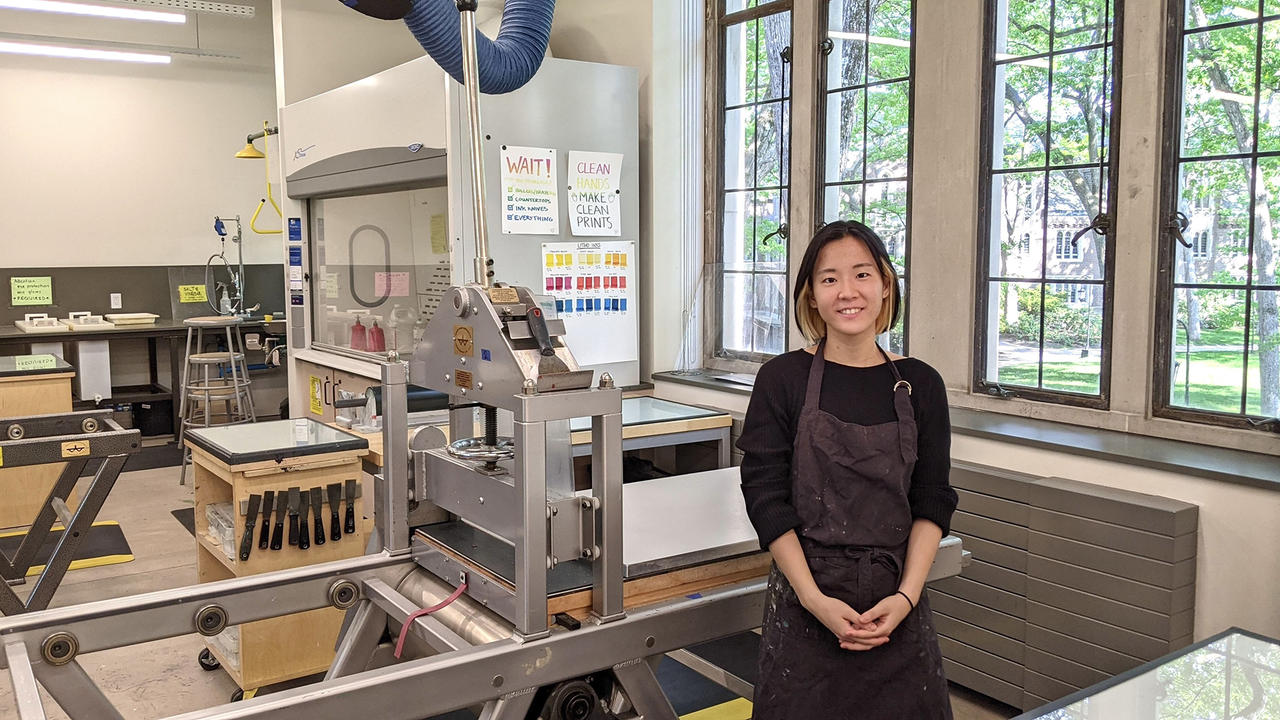Rinako Sonobe ’22, 2022 Thomas J. Watson Fellowship Recipient

This story was originally published as a Wellesley Spotling on June 21, 2022.
Rinako Sonobe ’22 is one of 42 recipients of a Thomas J. Watson Fellowship—a one-year grant that will allow her to travel and explore an interest of her choosing. For her application, she connected her interests in architecture and printmaking in a project called “Choreography in the Studio: Searching for Architectural Uniqueness.” “It’s about the architecture of the printshop,” she said. It’s also about the space within a printshop and the way the artist moves within it—the choreography of an artist making work.
Sonobe, who studied architecture and mathematics at Wellesley, plans to travel to Belgium, Argentina, Norway, Hong Kong, and Scotland to explore printshops, seeking to understand how “spatial arrangement can provoke creativity and collaboration, and what makes a studio environment so unique,” she said.
In her fellowship application Sonobe wrote, “I see the printshop as a place for all things: teaching, learning, experimentation, creation, expression, collaboration, communication, and inspiration.” She’ll visit each shop for up to three months to observe the artists and the spaces in which they work, create work herself, and learn about the architectural history of that shop’s city. “I want to take what I’ve learned from one printshop and pass it on to the others,” she said.
She’ll also create what she describes as a “visual dictionary of the activities and body movement that printmakers take around the press.” She chose the dictionary format, she said, because the product will be “a curated list identifying the different choreography of printing to reflect objectively and emphasize with logic the use of the unique materials and the specific skills of printmaking.”
Sonobe came up with the idea for the project while she was taking a break from Wellesley. When she started college in 2016, she was immediately drawn into the field of architecture, and took classes in the subject at MIT. At Wellesley, she studied printmaking and also took engineering and math courses—her longtime interests. As her enthusiasm for all these disciplines grew, how to connect them—specifically architecture and printmaking—for a thesis became less clear. She took time off, returned home to Japan, and worked as an architectural designer at a small engineering firm there. She stayed in Japan during the pandemic. “The two years was, I think, a good time for me to understand what I’m good at and how I want to grow,” she said. She had time to reflect on her Wellesley and MIT experiences as she gained industry experience and worked with many Japanese designers and engineers.
Once she returned to Wellesley, she decided to create a study of her own movements in the printshop in Pendleton West for her thesis, setting up a camera and capturing the precise steps she took around the lithograph press while printing a monotype. She then applied a regression-based algorithm to the video to document the relationship between the movement and the equipment space. She also wondered “what the printshop is without its printmakers,” so she created a time-lapse video of the empty space, capturing sunlight moving across the room, and providing an opportunity to see the space in shapes, lines, and textures—the elements of design.
Sonobe is drawn to the experimental nature of printmaking and the precision it requires. The process “is like a science experiment,” she said. “There’s all this preciseness that you need to follow, and it’s not just about the outcome, but it’s very much about the process that [takes you to] the final outcome. And if you change one small part of the process, it takes you to a different outcome. Printmaking is both traditional and experimental, and I see so much potential in the field.”
Asked what she hopes to take away from the Watson experience, she said “I just want to understand the process of how a studio space becomes so unique, and apply that as I try to become an architect in the future, to see how I can design these creative spaces, and how I can apply what I’ve learned in designing a park, a school, a museum, an apartment—the sense of play, the sense of creativeness that I think everyone should have access to.”



